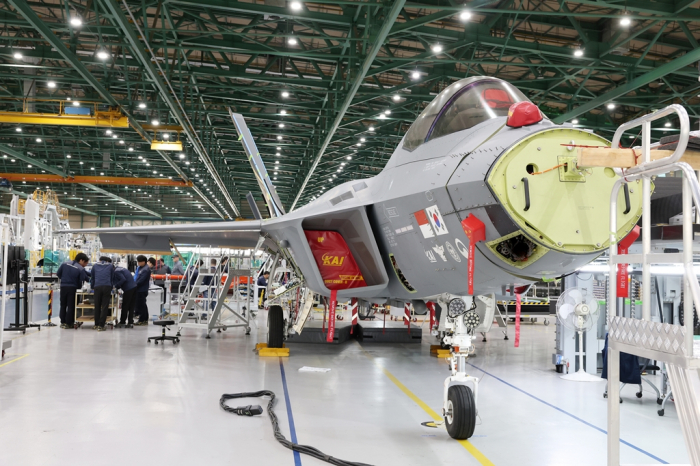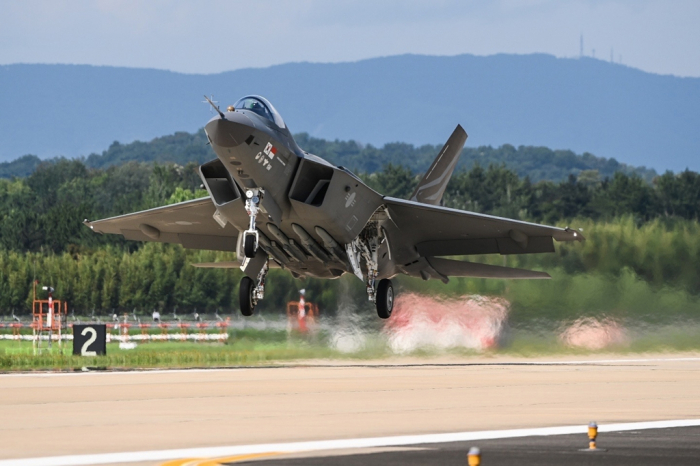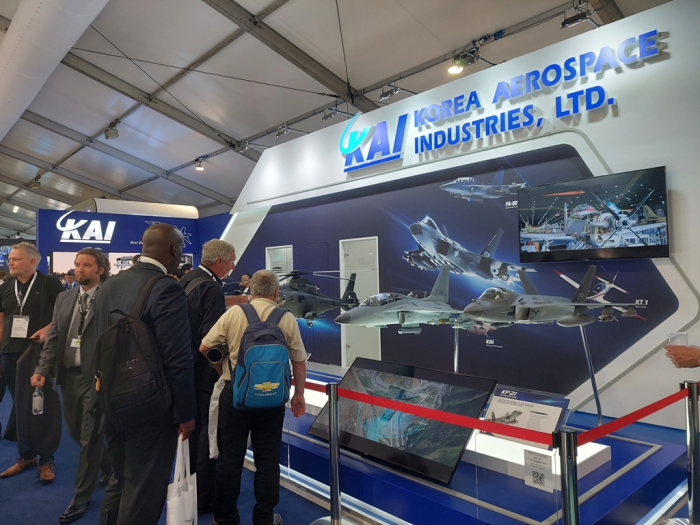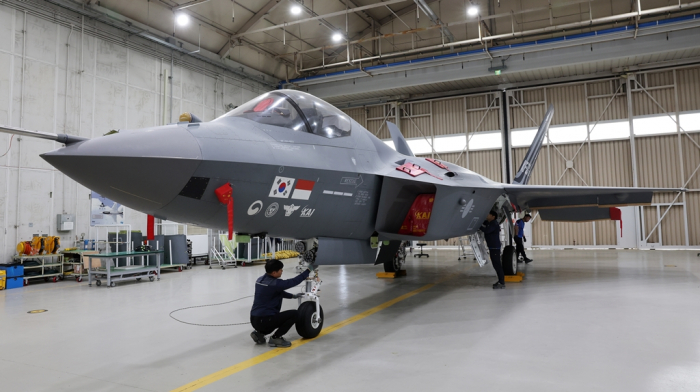KAI, bastion of South Korea’s fast-growing defense industry
With the outbreak of the Russia-Ukraine war, Korea is emerging as one of the world’s fastest-growing defense exporters
By May 03, 2023 (Gmt+09:00)
LG Chem to sell water filter business to Glenwood PE for $692 million


KT&G eyes overseas M&A after rejecting activist fund's offer


Kyobo Life poised to buy Japan’s SBI Group-owned savings bank


StockX in merger talks with Naver’s online reseller Kream


Meritz backs half of ex-manager’s $210 mn hedge fund



SACHEON, South Gyeongsang Province – On a hot spring day in April, the roar of combat aircraft engines fills the air. It’s a normal day at Korea Aerospace Industries Ltd., or KAI as it is more commonly called.
At a factory – three times the size of a soccer field – next to the area where test fighter jets fly over Sacheon every hour, technicians and engineers are busy assembling and inspecting the KF-21, a 4.5-generation supersonic fighter jet under development.
They are also working laboriously on the FA-50 light combat aircraft, the country’s key defense export item.
“The (aircraft) body is filled with hundreds of thousands of parts and electric wires that run for kilometers,” Lee Ho-kyu, head of Korea Aerospace’s fixed wing assembly technology team, said of the KF-21 aircraft.
The KF-21’s performance surpasses that of North Korea’s main fighter jet, the MIG-29, and is nearly on par with Europe’s next-generation fighter jet, the Eurofighter Typhoon, he said proudly.

KAI, Korea’s sole military aircraft manufacturer, and the Defense Acquisition Program Administration (DAPA) under the Defense Ministry are jointly developing the KF-21, Korea’s first supersonic fighter jet. The Korean defense companies are putting the final touches on the combat aircraft with technological help from US defense company Lockheed Martin Corp.
KAI and DAPA have invested a combined 8.8 trillion won ($6.6 billion) in the KF-21 project, which the country expects to take its defense industry to the next level.
KOREA, KEY PLAYER IN GLOBAL DEFENSE MARKET
Since the start of the Russia-Ukraine War, Korean defense companies have emerged as major defense players, engaging in active weapons export negotiations.
According to the Korea Institute for Industrial Economics and Trade (KIET) and Aviation Week, a global defense journal, the weapons acquisition budget worldwide is estimated at $680 billion this year and is forecast to grow to $700 billion by 2027 and $750 billion by 2032.
Recent data from the Stockholm International Peace Research Institute (SIPRI) showed that Korean defense exporters are rising rapidly in the global market.

Korean companies’ global weapons market share was 2.4% in the 2018-2022 period, up from 1.3% in the previous five-year period, the fastest growth rate among the world’s top 10 defense exporters.
Last year, Korea's defense industry posted a record $17 billion in exports, more than double its previous record of $7 billion in 2021, boosted by strong sales of the FA-50 fighter jets, the K2 Black Panther battle tanks and the K9 self-propelled howitzers.
Korean President Yoon Suk Yeol said last year his government aims to turn the country into one of the world’s four largest defense exporters.
CHALLENGES REMAIN
Korean defense companies are known for their cost-effective and cutting-edge technology in manufacturing weapons and fast delivery of such weapons.

In February, KAI said it aims to achieve 3.83 trillion won in revenue this year, up 37% from 2022, driven by sales of advanced fighter jets.
Orders for military equipment will reach 4.48 trillion won by the end of 2023, although some of this won’t be reflected in this year’s results, it said.
Last September, KAI signed a $3 billion deal to export 48 FA-50 fighter jets to Poland by 2028. In the long run, the company aims to sell 1,000 units of the FA-50 light combat aircraft worth 40 trillion won over the next decade.
Analysts say Korea needs to focus on value-added weapons with higher price tags to move up in the global rankings.

“With the outbreak of the Russia-Ukraine war, NATO countries are backing German defense companies. Germany is one of the toughest rivals for us in our efforts to enhance our presence globally,” said KAI Chief Executive Kang Goo-young.
Other key export items of Korea’s defense industry include Hyundai Rotem Co.’s K2 Black Panther, a next-generation battle tank; Hanwha Defense Co.’s K9 self-propelled howitzers; LIG Nex1 Co.'s mid-range surface-to-air missile (M-SAM) system called Cheongung in Korean, or heaven’s bow; and Poongsan Corp.'s ammunition and artillery shells.
Write to Ik-Hwan Kim at lovepen@hankyung.com
In-Soo Nam edited this article.
-
 Aerospace & DefenseKorean aircraft maker KAI earmarks $3.4 bn in R&D investment by 2032
Aerospace & DefenseKorean aircraft maker KAI earmarks $3.4 bn in R&D investment by 2032Mar 17, 2023 (Gmt+09:00)
2 Min read -
 Aerospace & DefenseS.Korea's KAI signs $105 mn deal to supply parts for Boeing aircraft
Aerospace & DefenseS.Korea's KAI signs $105 mn deal to supply parts for Boeing aircraftFeb 28, 2023 (Gmt+09:00)
1 Min read -
 Aerospace & DefenseKAI expects 2023 sales to grow by a third, driven by fighter jets
Aerospace & DefenseKAI expects 2023 sales to grow by a third, driven by fighter jetsFeb 15, 2023 (Gmt+09:00)
1 Min read -
 Aerospace & DefensePoongsan’s sale of ammunition, artillery shells surges on Ukraine war
Aerospace & DefensePoongsan’s sale of ammunition, artillery shells surges on Ukraine warJan 24, 2023 (Gmt+09:00)
2 Min read -
 Aerospace & DefenseHyundai Rotem delivers first batch of K2 tanks to Poland in $3.4 bn deal
Aerospace & DefenseHyundai Rotem delivers first batch of K2 tanks to Poland in $3.4 bn dealDec 07, 2022 (Gmt+09:00)
1 Min read -
 Aerospace & DefenseKAI targets to sell 1,000 units of FA-50 light attack aircraft worth $30 billion
Aerospace & DefenseKAI targets to sell 1,000 units of FA-50 light attack aircraft worth $30 billionJul 22, 2022 (Gmt+09:00)
3 Min read -
 Aerospace & DefensePoland closer to deal to buy South Korean fighter jets, tanks, howitzers
Aerospace & DefensePoland closer to deal to buy South Korean fighter jets, tanks, howitzersJun 20, 2022 (Gmt+09:00)
2 Min read -
 Aerospace & DefenseHanwha, Poongsan, LIG Nex1 clinch $989 mn Saudi defense deals
Aerospace & DefenseHanwha, Poongsan, LIG Nex1 clinch $989 mn Saudi defense dealsMar 10, 2022 (Gmt+09:00)
2 Min read


